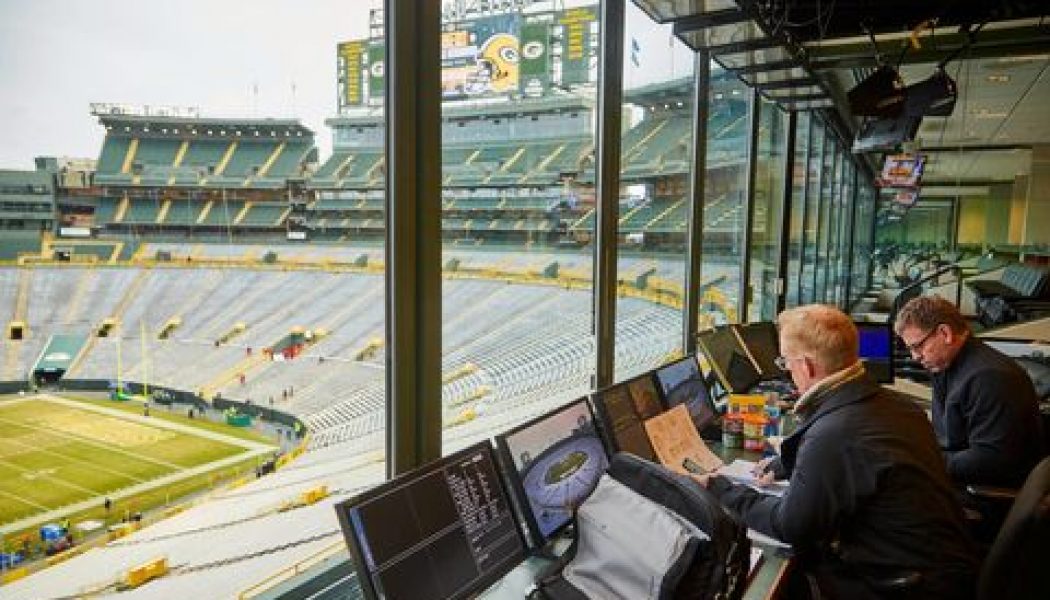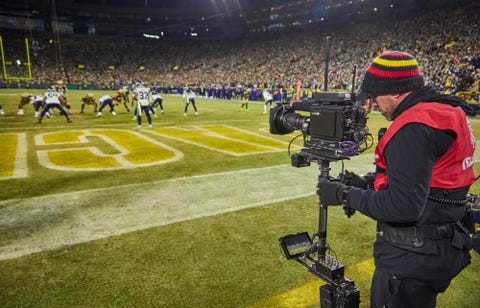The Truck
“After review, we had additional footage that came in that did not change the ruling,” said referee Clete Blakeman. “The ruling on the field stands as called. It is Green Bay’s ball, first down.”
“What?” came the collective shout in the production trailer.
“Additional footage?”
“What do they have, a cell-phone video?”
“The McGruder tape,” somebody said. Presumably, they meant the Zapruder Film. But let’s cut ‘em some slack—there was a lot going on. The Seattle Seahawks and Green Bay Packers were locked in a divisional-round playoff matchup at Lambeau Field, and tight end Jimmy Graham had just secured a first down for the home team that, with less than two minutes left, would surely allow them to advance to the NFC Championship game. The decision was contentious, the kind of NFL postseason moment that powers a Sports Media News Cycle on Twitter and the Monday morning debate shows, and the league was getting its video of the incident from Fox Sports, the employer of everyone in this room.
First down was the ruling on the field. But the play went to review at the league replay center in New York. After a couple of minutes, they upheld the decision. Blakeman went to the sideline screen to look at it again. Then he got on the mic once more, talking about new video that still didn’t sway the decision. Meanwhile, the folks in this trailer had supplied the video to New York and were not familiar with any additional footage.
“Jack,” said the lead producer, Richie Zyontz, wheeling around in his swivel chair in my direction with a grin. “What the hell is happening here?”
Zyontz runs the broadcast for Fox’s marquee games alongside director Rich Russo, and both describe the production process as “organized chaos.” For the divisional round, they oversaw 26 manned cameras and around 45 in total—with the pylon cameras and some down-the-line angles and plenty more—from a couple of trailers, which they call “the truck,” parked outside the stadium. The day I joined them, they sat front and center in the main production trailer with two dozen screens on the wall in front of them featuring the live feed of the broadcast, plus footage that’s queued up to run next, six-a-screen thumbnails of the many cameras. They wore headsets, keeping them in constant contact with everyone in all three trailers, plus the announcers in the booth, the sideline reporters on the field, and network headquarters in Los Angeles. In all, Fox employed some 225 people on the divisional-round broadcast. They brought around $25 million in equipment with them to Green Bay.
There are enough moving pieces to make anyone’s head spin when everything goes to plan, which it did not a week earlier in New Orleans. This Fox team broadcast the Vikings-Saints game in the wildcard round, and they faced a true television disaster in the Superdome: The Skycam, which is suspended over the field of play to provide something of a bird’s eye view, lost power and tumbled from the sky during a Vikings drive.
“I’ll be honest with you,” Zyontz told me, “When the Skycam went down, it was the first time for me. I started shaking a little bit, because I immediately thought about what—or who—we could have hit. We really dodged the bullet. It just lost power. And I think everybody handled it the right way. But it’s playoff game. You don’t want any of that to happen. And it’s out of your control. It’s something that just happens, and you just have to react.”
In the end, a significant technical fiasco occurred without viewers much noticing. He and Russo view that result as one of the great accomplishments for a production team. It’s another formative experience in a career’s worth, but it came at as good a time as any. The stakes are only getting higher. This Sunday, Fox will bring even more staff, and even more gadgets, down to Miami for the Super Bowl. It’s nearly time to put on a show for more than 100 million people.
The Booth
A packed elevator rose from the bowels of Lambeau up towards a mezzanine looking over the main loop of concession stands and restrooms. “You’re about to experience the coldest walk in sports,” said Troy Aikman, the Hall-of-Fame quarterback and color commentator on the Fox Sports NFL A-Team who towered over the other passengers. The whole car chuckled as the doors rumbled open. Even at mid-afternoon, hours before game time, it was brisk indeed. The temperature at kickoff on this January Sunday in Green Bay was 23 degrees.
This level, only reachable after you show your pass at three security checkpoints, is reserved for stadium staff and the production team. It’s also the way to the broadcast booth, so getting there means walking the path fully exposed to the Wisconsin elements for a decent chunk of the empty stadium’s circumference. When the stands are open, the smell of bratwurst and cheese curds and kielbasa wafts up over the sea of green and yellow below. But it was deserted underneath us as we trudged along until we reached another elevator, which brought us up to the fourth floor.
If the players have to prepare for the conditions, so does the production team. Behind the green doors to the announcer’s booth, there’s a landing with a restroom to the right. “If a booth has a bathroom,” Aikman says, “it’s a great booth.” Lambeau’s booth is decently wide and very deep. Plenty of space for the monitors and equipment chests and, on the left, a giant green screen with two stools where Aikman and his partner, play-by-play announcer Joe Buck, will move at some point in the broadcast. For the most part, though, they’re seated right up against the wall of windows looking out on the stands and the football field below. Except well before the game even starts, they’ll throw open all the windows and subject themselves to the ferocious winter winds for more than four hours straight.
“It’s the coldest booth in the league,” Aikman says. “We’ll do games in places that are just as cold or colder, temperature-wise. But this booth—the whole front of our booth is wide open. So it’s the biggest opening, and then it’s open right out. Other places, there’s that overhang, so the wind doesn’t blow in. This, whatever the temperature is outside, it’s that cold in the booth.” In 2008, when Eli Manning and the Giants came to town and upset the Packers on their way to a Super Bowl, the temperature clocked in at one below with a wind chill of negative-23. At one point, Aikman started googling the symptoms of frostbite.
At this time of year, Buck and Aikman ditch the coat and tie for more functional attire. And that doesn’t just mean full jackets and gloves—soon after we arrived, Aikman was debating whether to wear a heated vest. A booth staffer took it out of a cabinet and made the case. Aikman said they can be finicky, though, and he had a new (non-heated) vest from Vince he was eager to flex. The staff packed enough hand-warmers for a small army. Everyone was bundled up inside, part of the semi-annual tradition of staying alive in the Lambeau broadcast booth. Aikman remembered a few years back, when Buck spent the week leading up to a Packers game assuring Aikman that he had a solution. Don’t worry man, I’ve got us covered. They showed up on game day and Buck took a seat behind the big windows and opened up his bag and whipped out a portable heater about the size of a coffee thermos.
The preparation for a broadcast destined to reach over 35 million people requires much more than a heater or an electric fleece. Everyone I spoke to, both on-air talent and the production team, estimated that they use about 10 percent of the research and stats and other materials they prepare for a game.
For Buck and Aikman’s part, prepping means reading media clips on the two teams and the matchup in the week prior, watching film from each team’s previous outings, looking back on notes that date back to preseason, and working with producers to cook up what they call their “cards,” which are actually multi-page packets, front and back, that are stuffed full of statistics and factoids and player profiles, most of which they’ll never use. Buck described it as a “safety blanket”—you like having it there, but you can’t sit around looking at it. He needs his eyes on the field, and on the screens in front of him which, via the corner of his eye, he can use to see what the folks in the truck are showing viewers at home.
There are 12 to 15 people in various stats roles on any given Sunday, but a lot of the job is reacting in real time. Helping this all along is a genuine friendship between Aikman and Buck. Aikman shared that they’ve each got two daughters, though Buck’s are a bit older. They worked together as both went through a divorce around the same time, and got remarried. They’ve been on the air for 18 years now, and it shows.
“I know his rhythm,” Buck says. “It’s almost like a big dance. I can tell, when I’m doing the play by play, just by how he’s moving his body. He’ll either turn to me a little bit. I’m sure he’s not even aware he does it, but he does it. Or he’ll lean in a little bit and I know he’s like somebody in a starting gate, ready to go. I need to shut up because he’s going to jump in there.”
But it’s not always seamless.
“If I really want to get his attention, for something that I want him to for sure hear—because I’m only saying it to get his reaction off it—I’ll grab his arm just to get his attention.” Buck mimicked a fairly forceful tugging motion. “If I feel like we’re starting to get on two different pages, I’ll just literally grab his arm and say, ‘Hey, when we talked to Drew Brees two days ago about the zone blitz, he told us this was going to be a problem.’ And now he’s heard me say that, and he can react.”
Real-time reactions like this make up much of the art in the job. Buck’s father, Jack, was an announcer for the St. Louis Cardinals for decades, and Buck the younger recalled a story where his father was partnered up with a new co-commentator who was a bit nervous ahead of the broadcast. He sat down in the booth with pages and pages of notes. He scoured them relentlessly as they moved towards the first pitch until Buck the elder, with a kind of brutal wisdom, simply threw the guy’s notes out the window of the booth. Overpreparation, Buck said, is a particular problem for the Super Bowl.
“It’s horrible. I asked [Packers head coach] Matt LaFleur that question on our conference call. You had an extra week. Do you find yourself fighting the urge to become a different team in those two weeks? We have to fight the urge to become a different broadcast. You start getting down into the weeds and into that minutia. [Viewers are] just like, Shut up. We’re at a Super Bowl party. We just want to watch the game. We don’t want you talking through the whole thing.”
Some talking is required, however, particularly as the game—and what fans have come to expect from it—has evolved. Some combination of technological innovation, the explosion of fantasy football, and the social media news cycle has created legions of fans who now demand more stats, more context and background information, more camera angles.
“This has become more of a high-wire act than it’s ever been,” Buck said, “with really much more well-informed fans than I think there were when I started. People know what’s going on in the NFL, and just the overall tonnage of coverage every day—I’m trying to keep up with some of the viewing public. That makes you work harder, because you know the people you’re talking to are a lot more informed than they were 10 years ago.”
Plus, the NFL rulebook constantly evolves, with new penalties and tweaks to existing policy every year. As a result, Mike Pereira—the former vice president of officiating at the NFL whom Fox brought over as a rules analyst in 2010—has enjoyed a growing role during the broadcast. Pereira now has a seat in the booth and even a button that allows him to jump into the live conversation.
And he has to. Ahead of the 2019 season, the league made subjective judgments on pass-interference calls reviewable, meaning decisions that were once left up to officials’ judgment on the field can now go to New York to be litigated further. “We all looked at each other in our NFL seminar,” Buck remembered, referencing the preseason meeting broadcasters have with the league about rule changes and whatever else, “Like, ‘Oh my God. Now we’re opening this can of worms.’”
“I will bet you as sure as I’m sitting here,” Buck told me, “Something big will happen before the end of the Super Bowl. Before that final play, something will have happened where it’s like, ‘What? What has happened? What’s the call here, and why is that the call?’”
The Field
Down on the field, the play moves like lightning. A Green Bay receiver ate up the ground for a first down and more, and suddenly an army was mobilized—and not just between the sidelines. Erin Andrews came marching down the line behind the Packers bench with at least three or four people in tow—assistants, makeup folks, and crucially, the screen man. Both the sideline reporters—Andrews is joined by Chris Myers for big playoff games—are accompanied by a staffer carrying a mini-screen on which they can watch the game as it appears on TV. The Andrews crew was followed by a double-camera stand, elevated to provide two different angles, and about seven more people tending to it. Officials in NFL regalia were directing traffic, clearing folks out of the way so the TV squads and their writhing thickets of wires can get to where they need to go.
This organized chaos will factor in down in Miami, too, but the Wisconsin weather added another dimension. No one is at the mercy of the elements quite like the sideline reporters, who head out on the field two hours before gametime. That’s when they get their best material chatting with the players, “when they don’t have their unis on,” Andrews told me. “They’re kind of in their gear, they’re FaceTiming, they’re talking to somebody at home. I think it’s where they feel the most comfortable, versus being on a conference call or in a meeting room with us. It’s their turf.”
The pregame work, the postgame interviews, the game itself—it all adds up to five hours straight in the wind and cold when all is said and done. “There are times you can’t form a sentence and your tongue gets super, super heavy, and your lips get stuck together,” Andrews said. “You sound like a complete idiot.”
The heat can be just as big a problem. The teams have massive industrial heaters by their benches, right in the area where a sideline reporter might operate.
“The Panthers were playing here,” Myers remembered. “I had a long coat and I was leaning in on the heater. You know they have those gas heaters. And one of the players was like, ‘Hey, your jacket’s smoking.’ And it had caught fire. So I had to run and put it out.”
“I once stuck my boot up there to warm my feet and my pants melted,” Andrews said. “Those puppies are so hot.”
Myers, who also works some games from the booth when Buck has a different assignment, is a Florida native who lives in California. Apart from a brief period in Connecticut working for ESPN, he’s never spent much time in these colder climes.
“My first time here, I was covering the sideline, and I got here without the proper cold-weather gear. So I just threw on coats, I bought extra hats, and when they came down to the field I think Joe Buck said I looked like Elmer Fudd. Aikman was laughing hysterically.”
So he went searching for a new strategy.
“Another time, I had one of these electric vests, and it was short circuiting,” Myers admitted wryly, “and shocking me like a shock collar.”
It’s also five hours without much chance to eat, and zero chance to visit the restroom, a reality reflected in Andrews’s pregame routine: “Peanut butter sandwich. I probably have about four cups of coffee, which is horrible for my heart before. And I mean, if you want to go there—take a pee, go tinkle. We don’t have a chance to use the restroom at all during the game. I am full bladder central. Last week, it went to overtime in the wildcard game and I was like, ‘Oh my God, I’m going to pee my pants.’ There’s no place to go to the bathroom and there’s no time. And for me, honestly, I don’t want to miss anything. So my husband’s always like, ‘Do you realize what you’re doing to your bladder and your kidneys?’ I’m like, ‘Yeah, well, it happens.’”
Ahead of the game, Andrews and Myers read the clips from local and national press and watch tape from previous games. Andrews always calls her dad for his two cents. Their emphasis is on identifying the storylines coming into the game. The day before the game, Andrews pointed to a much-anticipated matchup between Seahawks receiver D.K. Metcalf and the Green Bay secondary. She’d looked into the possible coverage, spoken with Metcalf’s position coach, “so when Joe and Troy talk about the matchup, I can say, Well, I was speaking with so-and-so and he told me this about so-and-so…”
Myers and Andrews are thus another part of the big dance they’re all doing: Buck and Aikman dance together, but they’re also moving in time with Zyontz and Russo in the truck, who in turn are dancing together, but who are also in constant back-and-forth with Andrews and Myers, who have to be able to waltz into the same phase Buck and Aikman are in for a 30-second sideline report. It’s like a party scene from a Victorian period piece, where the dancing pairs move in concert with all the others so nobody steps on anybody else’s toes. And the tempo speeds up every year.
“The time is so valuable, because of the pace of the game with hurry-up offenses and no-huddle,” Myers said. “So there’s not a lot of time to get any information in. Joe and Troy have their normal flow of the game. We have Mike Pereira, you have commercials. For example, I’ll just go to last week. There was a moment where it was, ‘Hey, how come Dalvin Cook isn’t in the game?’ They’re not sure, I’m on the sideline, I’m looking, his face guard had cracked and they’re replacing it. They didn’t have a backup helmet. So I’ll quickly hit the key, and sometimes I could just relay that information. Other times, Richie Zyontz will say, ‘Yeah, if you got it, go now.’ And Troy throws to me and I’ll just—watching the snap of the ball, you never want to talk over it because a big play could unfold. So you quickly just say, ‘Hey, his face guard cracked, that’s why he’s not in, they’re trying to repair it, they don’t have a backup helmet.’ And then boom, okay, they can go on.”
“One of the best places to be on the field is right where the quarterback comes out, especially at a three and out,” Andrews added. “Especially when they’ve been sacked, especially after an interception. They either say crap to the coach, or they say crap to their line.” She added that, due to NFL guidelines, she never quotes players and coaches directly during the game. You have to paraphrase.
You can prepare all you like, but it’s mostly just reacting. Andrews was working the Cleveland Browns game and was a few minutes away from interviewing Baker Mayfield when his teammate, Myles Garrett, smashed a helmet against Steelers quarterback Mason Rudolph’s bare head. (That’ll change the conversation quickly.) Andrews and the Fox production team also played a role in resolving the great Cowboys coin-toss debacle this season, when the referees said Dallas quarterback Dak Prescott hadn’t formally asked to receive the ball in the second half, meaning the L.A. Rams would get the ball to start both periods. Some detective work from Andrews and the camera-and-sound folks made it right before halftime.
And then there’s the unpredictability of standing up against the gridiron when dozens of the world’s fastest, strongest, and largest people are ferociously competing next to you. I asked Andrews if she’s concerned about the threat of getting hit with a projectile—or a human—while standing with her back to the field for a standup.
“Yes,” she said gravely. “Pam [Oliver] got nailed in the face a couple of years ago, and that is frightening. I mean that is so dangerous. There was last week before my feature, I think, for the pregame show the receiver’s coach was warming up somebody from the Saints and I just looked at my handheld and I was like, I’m not comfortable here. It’s just not worth it. It’s not. Players have helped me quite a bit, because I’ve almost gotten nailed. But I got hit with a line drive covering baseball for ESPN. I was on the third base side and my security guard actually ducked and I got nailed in the face. I went to the dentist the next day, and they said we have zero idea how you didn’t shatter your jaw. Says a lot about my mouth.”
The Broadcast
Spread across the three trailers in the Lambeau parking lot there are assistant directors, graphics people, replay editors—everyone who makes the thing go. An NFL game is a three-plus hour affair that features a little over 11 minutes of live action. The rest is replays, commercials, pieces highlighting players, coaches, tactics, the halftime show, the tease for the halftime show, sideline interviews, fan reaction shots, Skycam panning to set the scene. Making all this go, in sync and at the right time, is the responsibility of everybody in the truck. Even standard plays require remarkable precision.
“[Davante] Adams is the lone guy now for Aaron Rodgers,” said Aikman over the live audio for viewers at home. The truck watched from the standard sideline camera as the Packers quarterback snapped the ball and found tight end Jace Sternberger by the sideline. The receiver caught it and was swiftly greeted by Seahawks defender Jadeveon Clowney.
“Oooh!” everybody went in the truck.
“Catch was made, and Clowney on the tackle,” said Buck. In the trailer, Zyontz called for camera “purple” while Buck kept talking: “And, a flag on the play.”
“Wait, wait, wait, wait, wait,” said Russo, the director, from Zyontz’s right hip. Zyontz glanced to his left, at the many screens with thumbnails of all the other cameras they had available, looking for the right angle to show viewers what exactly had prompted the official to throw a penalty flag. He found it in moments.
“Ready green,” Zyontz said, pointing up and to his left.
“Ready green?” Russo echoed, to make sure the team was ready to roll a new camera.
“Green,” Zyontz said.
“Go green,” said Russo. Zyontz leaned back as “Green” went live on the broadcast feed after the flash of a “FOX Sports” graphic segue. The view seemed to be from a camera off the endzone behind the Packers line, which followed Clowney as he tracked Sternberger out to the sideline. It was this kind of thing Russo had discussed with his camera guys in a meeting three hours before the game, in which he laid out the key characters to keep a lens on—Clowney among them, along with star receivers and head coaches. “Produce your own cameras, to a certain extent,” he’d said, with the tone of someone repeating an old adage worn from a long season—and many long years—of doing this.
As soon as “Green” was rolling, they were onto the next. “Purple?”
“X, ready X? Roll X, dissolve X” Russo said, and the shot changed with a dissolve edit. A camera on the opposite sideline rolling in slo-mo appeared to show Clowney grabbing at Sternberger’s helmet to bring him down, contorting the receiver’s neck. But Aikman was casting some doubt that it constituted a penalty in the on-air commentary. Meanwhile, the folks in the truck were already onto the next one.
“Purple! Purple. Now purple.” And then we were behind the Seahawks end zone, watching clearly now as Clowney grabbed at the helmet of the receiver to bring him down. Fox’s rules analyst, Mike Pereira, jumped in to discuss whether Clowney’s hands had gone underneath the helmet. But in the truck, they were already on to showcasing the storyline. They moved to another sideline camera which zoomed in on Clowney and Sternberger, face masks clanging up against each other as they exchanged pleasantries. Then there was another “Fox Sports” graphic and a brief cut to three Seahawks players as they returned to the line.
“Referee’s on three. I got him on three,” Russo said. “Take three. Take three.” They cut to Clete Blakeman as he strode out to announce another decision.
“Go, Clete!” Russo said, still directing traffic.
“Personal foul, grabbing the helmet opening,” Blakeman said, making a vigorous yanking motion with his arm in front of his chin. “Defense, number 90.”
Zyontz and Russo went looking for Clowney on the screens all around them. “Gimme nine,” Russo said. “Take nine!”
They found the number 90 from a raised position on the sideline, trudging back into position for the next play after giving up a 15-yard penalty. The play itself had been no more than five or six seconds. On TV, it took up 71. Erin Andrews chimed in over the background audio feed, suggesting shots and offering snippets as she learned them on the sideline. Aikman jumped in to break down how the Seahawks secondary was operating so the production team could better track the play. And all the while, the production hummed along.
This coming weekend, they’ll do it all again for a Super Bowl audience, as the nation—and, increasingly, the world—settles in for a true American holiday. Everyone involved downplays the feeling going into it, not unlike the players they’re covering, claiming it’s just another game. But there are ways in which it just isn’t.
“You get to a Super Bowl, and there’s been two weeks worth of talk and hype and Media Day and all that,” Buck said. “Then they kick it off, and about three minutes in and you’re like, ‘Oh, okay, now we’re just covering a game.’”
I suggested it might be that way for the players, too.
“Yeah, it’s how it was for Troy,” Buck said, referring to Aikman’s playing days. “I mean, he said that. The pregame lineups is when he had a panic attack when he was playing, but then you settle in and play a game. Take it at your own pace. I don’t need to overdo it. You kind of start like a yippie quarterback. You throw a couple of check-down passes, or hand it off a couple of times. I’ll probably play it cool at the start and just not try to overdo it, and build up as my comfort builds up, and do more as the game goes on.”
“I’d be lying to you if I said it’s just another game,” said Russo. “When you get into a game of that magnitude, you almost have to tell yourself to just slow down a little bit. The more cuts I make as a director doesn’t mean it’s better anyway. You’ve just got to show what you think is the most important thing for the viewer. For me, honestly, when the teams come down the tunnel, there’s a sense of adrenaline that I get, but once the ball’s kicked, you have to treat it like any game. We have more equipment, more toys. But you can’t think about the 120 million people watching the game. Once you’re in the game, you just have to think about what you do every Sunday.”
























